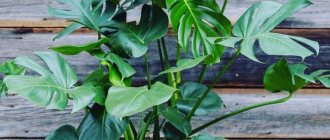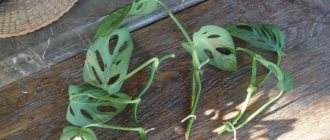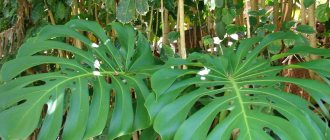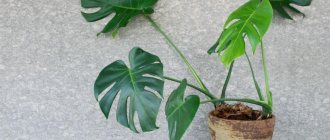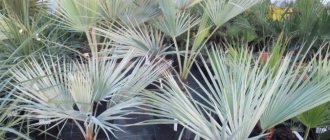Monstera is an evergreen plant native to the tropical forests of Central America. This exotic flower can be seen everywhere - in homes, offices, winter gardens and greenhouses. Particularly decorative are variegated varieties, which are more correctly called variegated. In such plants, the color of the leaves combines two colors - white and green. This feature allows you to make any design original. Monstera variegated is very unpretentious, but has certain care features.
Flower growers grow various varieties of monstera. The plant is valued for its decorative qualities and relative unpretentiousness. In favorable conditions, the plant can reach impressive sizes, forming powerful long shoots and large carved leaves.
Monstera variegata - decorative and exotic
Variegated varieties look even more attractive. The pattern of each leaf plate is not only beautiful, but also individual. It is impossible to find two leaves with the same color on such a plant. That is why the variegated monstera is very often an accent in the interior.
Botanical description
Monstera is a large evergreen plant of the Araceae family.
Its natural habitat is Central and South America, and is found in Asia. Translated, the name of the plant means “bizarre.” This is a vine with a thick climbing stem, which is covered with aerial roots. The height of the plant reaches 5 m. Large leaf plates are attached to long petioles. The young leaves are whole, then holes and slits appear on them, and they become dissected into several lobes. The inflorescence is a spadix surrounded by a spathe.
2.Description - what the plant looks like
A small genus of perennial evergreen vines that contains about 20 plant species.
The monstera flower is a very large and spectacular epiphytic plant that has well-developed, long, straight aerial roots, with which it clings to the support.
The roots of the vine are located not only in the soil - the plant has long aerial roots hanging from the trunk and also saturating the plants with moisture and nutrients. Aerial roots appear at leaf nodes opposite the leaf blades.
The leaves are dark green, glossy, round, up to 45 cm in diameter, located on long petioles - up to 30 cm, young leaves are whole, large leaves become carved. The newly emerged leaves are rolled into a tight tube and have a lighter, green tint. Carved leaves are necessary for the plant so that droplets of moisture can freely penetrate through them to the root system.
During the flowering period, the monstera throws out an inflorescence - an ear up to 25 cm long, surrounded by a white blanket. The flowering plant Monstera can rarely be found in indoor culture.
Photo: zoosnow
Ripe fruits are oblong and light green, edible and pleasant to the taste - reminiscent of pineapple, but they take almost a year to ripen.
In general, Monstera is a very beautiful vine and perhaps it got its name “monstera” or “monster” due to its gigantic size. There is another version - the plant was called monstera for its large, carved leaves.
↑ Up,
Photo: Forest and Kim Starr
Height . When grown in a home culture, indoor monstera can reach a height of 3 - 4.5 m, it grows quickly and gains up to 1.5 m in height over the season.
↑ Up,
Photo: Mokkie
Is it possible to keep Monstera at home?
How monstera blooms photo at home
Why you can: useful properties and signs
- Thanks to its large leaves, the monstera plant actively produces oxygen, evaporates moisture, thereby improving the microclimate in the room.
- The monstera flower actively purifies the air (absorbs electromagnetic radiation and formaldehyde evaporation).
- Monstera is recommended to be placed in offices, classrooms, and libraries. This is due to the fact that the energy of the plant has a beneficial effect on the nervous system: it puts thoughts in order, harmonizes the state of mind, helps to concentrate, and promotes informed decision-making.
- The plant also has a general strengthening effect on the body.
Why not
Monstera should not be placed in the bedroom, since photosynthesis occurs at night (oxygen is actively absorbed, which is unfavorable for a sleeping person).
general information
This plant is considered very tenacious and unpretentious, so even an amateur can grow it at home. You just need to know how to care for it, when and how much to water, fertilize, how to replant the monstera, etc. Gradually, as it grows older, holes begin to appear on the leaves, which then turn into fancy cuts. It is precisely because of its unusual beauty and unpretentiousness that this plant is so popular. We will tell you in this article how to care for it, water it and how to replant a monstera at home so as not to damage the root system. After all, in order for this large pet to please its owner with its beautiful, healthy appearance, it needs to be provided with certain conditions.
How to care for monstera at home
How to care for monstera at home photo
The plant is unpretentious in care; you just need to create optimal conditions for its development.
Where to put it in the apartment
- Monstera does not like to be moved from place to place, so it is advisable to immediately choose a suitable location.
- Direct sunlight will leave burns on the leaves.
- It grows poorly in deep shade and may die.
- Provide sufficiently bright but diffuse lighting, perhaps only light shading.
Air temperature
The plant is comfortable with a temperature range of 16-24 °C, and the vine can easily tolerate sudden changes. If the temperature is low, the growth rate slows down.
Watering and spraying
In the warm season, water intensively and regularly. With the onset of cold weather, you should water moderately, avoiding drying out the earthen clod.
Spray monstera regularly. Periodically wipe the sheet plates with a damp soft cloth or sponge.
Monstera in winter
- It is advisable for the plant to ensure that the temperature is reduced to 14-18°C.
- Drafts (open windows) are not allowed.
- We reduce watering so that the soil has time to dry out a little.
- We stop spraying; it is better to place a container with damp moss or a humidifier nearby, and wipe the leaves with a damp sponge.
- Feeding is stopped.
Top dressing
During the period March-August, apply complex mineral fertilizers for decorative deciduous plants every 2 weeks. Adult vines can be fed with organic matter: once a season, cover the surface of the soil with humus or pour in infusion of fermented mullein in a concentration of 1:20.
What to do with aerial roots
Aerial roots are involved in additional nutrition and hydration. They don't look very attractive. They should be collected, tied to the trunk, wrapped in moss. When watering, moisten the moss - this will only benefit the vine.
Lighting
Monstera favors sunlight. However, the sun's rays should not be direct, otherwise it can cause a burn on the surface of the leaves. The best option is diffused light. Monstera tolerates partial shade well. But absolute shade is contraindicated for it - in such conditions the plant will lose its decorative effect, the stem will stretch, and the leaves will become smaller, losing their bright color and characteristic shape. Therefore, in conditions of short daylight hours or in dimly lit rooms, it is recommended to illuminate the monstera with phytolamps until 12 hours a day.
How to prune and replant monstera
With age, the vine becomes longer and leaves fall off the lower part of the trunk. The plant needs rejuvenation. It is necessary in the spring to completely cut off the top part, leaving about 30 cm. After some time, young shoots will appear. The top can be used for propagation: lower it into water, and when the roots grow (preferably, they completely fill the container), plant it in the soil.
- Replant young plants (up to the age of 4 years) annually, then replanting is required approximately once every 2-3 years.
- Increase the size of the pot each time you repot. The root system is powerful and requires space. Choose a deep, wide pot.
- The thickness of the drainage layer should be 1/3 of the container.
For planting, you can use a universal substrate, a mixture for palm trees, or prepare a soil mixture: turf and humus soil, peat, sand in equal proportions.
Soil composition requirements
The acidity level of the soil for a monstera should be neutral or slightly acidic - at its young age and more acidic - every year in adulthood (that is, with an increase in the amount of peat in the soil mixture). Each gardener has his own opinion on the choice of soil composition for this exotic plant, so you can choose from several options:
Why do monstera leaves turn yellow, dry out and fall off?
Improper care negatively affects the appearance of the plant:
- Leaves dry out due to lack of moisture or nutrients.
- If the soil is waterlogged, the leaves begin to turn yellow, and the roots rot, an emergency replanting is necessary.
- The trunk of a young plant becomes bare, growth rates slow down - the lighting is insufficient.
- The edges of the leaf blades turn brown - the air is too dry or the root system is cramped in the pot.
- When exposed to direct sunlight, the leaves become covered with yellow spots.
- The leaf blades remain intact - the plant does not have enough light or nutrients.
- Due to increased air temperature, the leaves turn yellow and fall off (not to be confused with the natural gradual fall of leaves from the lower part of the trunk).
Care after transplant
The transplanted plant does not require special care, but in order for its “transportation” to be the least painful, it is recommended to follow a few simple rules.
Important! In cramped conditions, the monstera can wither and even die.
Watering and fertilizing
When the plant is already in a new pot, it needs to be provided with high-quality fertilizing, which will allow it to quickly adapt and fully nourish the root system. Since transplantation is a kind of stress for a tropical flower, experts recommend closely monitoring its condition during the first week. It is necessary to water the plant quite often, as the soil dries out, but do not allow it to form a swamp on the surface of the soil.
Pruning and shaping monstera
After replanting, a young plant does not need pruning or crown formation. But in an adult, it is recommended to cut off the top - this will speed up the growth of lateral stems and make the plant more voluminous.
Why do monstera leaves turn black?
Monstera turns black due to stagnation of moisture in the pot, which can be caused by insufficient drainage and/or excessively frequent, abundant watering. The root system begins to rot, and the rot spreads to the entire plant.
An emergency replanting with soil replacement and fungicide treatment is required. Free the roots of the plant from the soil, cut off the rotten ones, and plant them in a disinfected pot with fresh soil. Do not forget to lay a drainage layer of small pebbles on one third of the pot. After transplanting, pour phytosporin solution and treat the leaves with it.
How to propagate monstera at home
How does monstera reproduce? This plant is sometimes propagated by seeds, but mainly vegetatively.
Growing monstera from seeds
Monstera seeds photo
- To sow seeds, fill the container with light, water- and breathable soil.
- Plant the seeds shallowly, at a distance of 4-5 cm, moisten the crops, cover with transparent glass or film.
- Maintain the air temperature at 25 °C.
- Ventilate the greenhouse regularly and moisten the soil.
- Shoots will appear in about a month.
Monstera from seeds photo seedlings
- Plant the grown seedlings in separate pots.
- At first there will be only juvenile, undissected leaves; after 5-8 months of growth, real dissected leaf blades will appear.
Propagation of monstera by cuttings
How to cut a monstera cutting photo
- Can be propagated by apical and stem cuttings.
- Do this in spring time.
- The cutting must contain one node and at least one mature leaf, preferably an aerial root primordium.
- Make the upper cut above the kidney, it should be straight, the lower cut should be oblique.
- Root into the soil. The unit should be immersed halfway in the ground.
- Cover with a jar or plastic bottle and water through a tray.
- With the appearance of young shoots, they can be replanted separately.
Reproduction by lateral shoots and rhizome division
Reproduction of monstera by lateral shoots
Lateral shoots appear at the bottom of the stem - root them in spring. The shoot must have aerial roots and leaves. They can be planted immediately in separate pots.
When transplanting adult plants, the rhizomes can be divided. Each division must contain part of a rhizome, a full-fledged leaf rosette or a growth bud. Place in separate containers.
Types of monstera with photos and names
Monstera adansonii monstera adansonii
Monstera Adansonii monstera adansonii variety swiss cheese vine photo
It can reach a height of about 8 m. The length of the leaf plate is 20-55 cm, width - 15-40 cm. They are ovoid in shape, covered with holes. Flowering: spadix surrounded by a yellowish veil.
Monstera Borsiga monstera borsigiana
Monstera deliciosa borsigiana Variegated photo
The cyst plates are heart-shaped, evenly incised, and painted dark green.
Monstera pierced or full of holes Monstera pertusa
Monstera pierced or full of holes Monstera pertusa photo
The length of the leaf plates can reach 1 m, they are dotted with holes of various shapes.
Monstera deliciosa or attractive Monstera deliciosa
Monstera deliciosa or attractive Monstera deliciosa photo
The leaf blades are heart-shaped, pinnately dissected, and covered with holes. The peculiarity is that this species bears fruit. After flowering, a soft berry appears that tastes like pineapple. Fruit ripening lasts about 10 months (at home).
Monstera oblique or unequal-sided Monstera Obliqua
Monstera oblique or unequal-sided Monstera Obliqua photo
Climbing liana. The ellipsoidal leaf plates are covered with large oblong-shaped holes, the edges are solid. The halves of the leaf are slightly different in size: one is larger than the other, which is where the name comes from.
Monstera Karvinskyi Monstera karvinskyi
Monstera Karvinskyi Monstera karvinskyi photo
The height of the plant reaches 3 m. The young leaves are whole, then they are cut into blades, and holes appear on them.
Monstera acuminata
Monstera acuminata photo
The leaf blades are solid with pointed tips; over time, holes appear in them.
9 Comments on “Monstera houseplant Care at home Reproduction and replanting Photos of species”
I saw it in natural conditions on the island of Sri Lanka. Very beautiful liana! It's a pity that you can't attach a photo to a comment.
Hello Irina! We have added this feature especially for you. We will be glad to see your photos! Just refresh the page by holding down the Shift key to see the image upload form.
How amazing! I am attaching a photo
